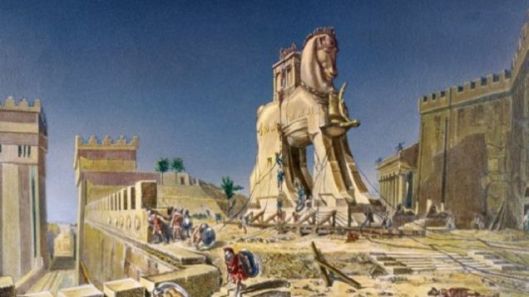
The chief source on the siege of Troy is Homer’s great epic, the Iliad. Its 24 chapters treat the last year of the siege; however, it was composed two or three centuries after the siege. Modern archaeological excavations have revealed a series of strata that identify a number of different cities built on the site. The one associated with the siege is the seventh stratum (from the bottom). It bears traces of a fire, and according to Homer, a great fire ended the siege. Scientific experts agree that the fire in the seventh stratum occurred in 1184 BCE. Homer tells us that the siege of Troy by the Mycenaeans (the mainland Greeks) went on for 10 years, hence the starting date of 1194 BCE.
The siege was undoubtedly motivated by economics. Located at the southern entrance to the Hellespont (present-day Dardanelles), Troy controlled the important trade between East and West, that is, from the Black Sea to the Mediterranean. Along this route flowed such commodities as grain, precious metals, and timber to construct ships. Troy was allied with a number of other neighboring city-states, and the Mycenaeans saw this as a threat to their position in the Mediterranean. Homer tells us that the cause of the conflict was the rape of Helen, wife of King Menelaus of Sparta, by Paris, the son of King Priam of Troy. Helen fled to Troy with Paris, possibly taking part of Menelaus’s treasure. Another account has the Trojans turning an official visit to Sparta into a raid of revenge for something done to them by the Greeks.
In any case, according to Homer the city-states of Greece were outraged and provided both contingents of troops and 1,200 ships, which then came under the command of Agamemnon, king of Mycenae and the brother of Menelaus. Homer tells us that on the Greek side the greatest heroes of the fighting were Achilles, king of the Myrmidons of Thessaly, and Ulysses, king of Ithaca. On the Trojan side there were Hector, son of Priam, and Aeneas, son of Venus and Anchises.
Following an unsuccessful effort to take Troy by assault, the Greeks settled in for a siege, which apparently was not complete. The Trojans were able to communicate by land to the interior most of the time. Homer indicates that the ships were brought up on land, where they were protected by entrenchments. Quarreling between Agamemnon and Achilles served to divide the Greeks, allowing Hector and the Trojans to attack and destroy a number of the beached Greek ships. Following the deaths of a number of prominent figures on each side (including Hector and Achilles), the Greeks found themselves in desperate straits. Both sides, however, were exhausted by the long siege.
At this point Ulysses came up with the ruse of an enormous wooden horse. Left on the field, it contained Ulysses and a number of other Greek warriors. The remaining Greeks boarded their ships and sailed away. The Trojans, believing that the Greeks had given up, thought that the trophy had religious significance and brought it inside the city. At night Ulysses and his warriors climbed down out of the horse, signaled to the fleet offshore, and opened the city gates. The Trojans were taken by surprise, and the city was burned.
Some have suggested that the alleged Trojan horse that ended the siege was instead a great movable siege tower of wood covered by horse hides for the protection of those working it, which the Greeks set against the western, and weakest, part of the great wall that protected the fortress. Others believe that the wooden horse refers to some type of battering ram or to the image of a horse painted on one of the gates of the city, which was opened by a Trojan traitor. In any case, as a consequence of their victory, the Greeks secured control of the important trade through the Dardanelles and the Black Sea.